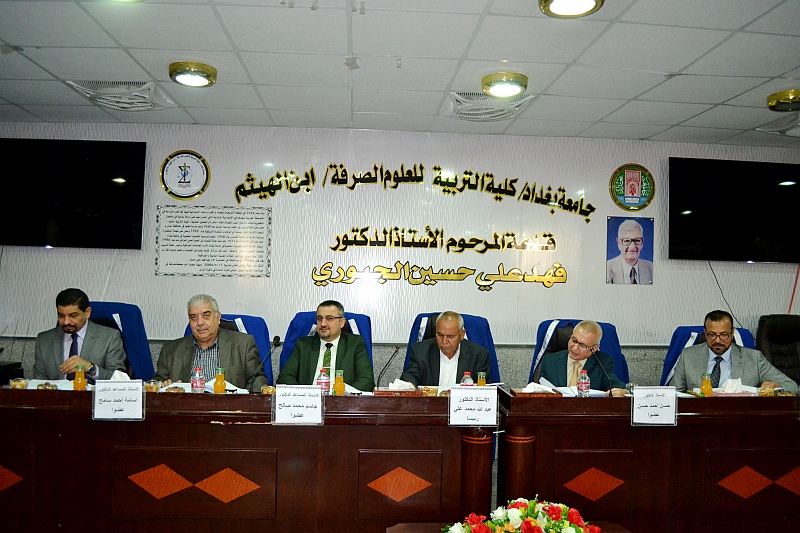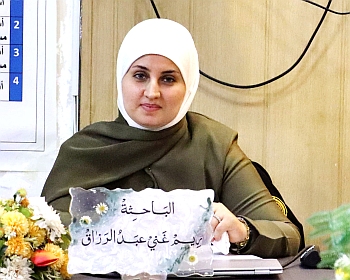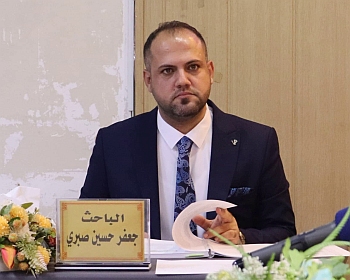ناقش قسم الكيمياء في كلية التربية للعلوم الصرفة (ابن الهيثم) اطروحة الدكتوراه الموسومة ( المعقدات الفلزية المشتقة من ليكاندات متعددة السن؛ تحضير، التشخيص الطيفي والفعالية البايلوجية ) للطالب (طالب حامد موات ) التي انجزها تحت اشراف التدريسي في القسم (أ.د. محمد جابر الجبوري).

ونوقشت الاطروحة من قبل السادة اعضاء لجنة المناقشة :
-
أ.د.عبد الله محمد علي رئيسا
-
أ.د.حسن احمد حسن عضوا
-
أ.م.د.جاسم محمد صالح عضوا
-
أ.م.د.عيد صالح محمد عضوا
-
أ.م.د. اسامة احمد سامح عضوا
-
أ.د.محمد جابر ابراهيم عضواومشرفا
ويهدف البحث الى دراسة التكوين والتشخيص الكيمو- فيزياوي والخصائص الحرارية والفحوصات البيولوجية لليكاندات سيلينيوسيميكاربازون الثنائية السن (تحمل ذرات المانحة N و Se) ومعقداتها الفلزية. لذلك ، فإن الهدف من العمل الحالي يشمل:
-
تحضير ستة ليكاندات سيلينوسيميكاربازون قاعدة-شيف جديدة (HL1-HL6) ، والتي تم تحضيرها بعدة خطوات.
-
تكوين عدد من المعقدات الفلزية من تفاعل ليكاندات مع أيونات فلزية متعددة.
-
استخدمت مجموعة من التقنيات الكيمو- فيزياوية لاثبات تكوين الليكاندات ومعقداتها الفلزية.
-
استخدمت الكيمياء الفراغية للتنبوء بالتركيب المحتمل للمركبات المحضرة.
-
استخدمت تقنيات التحليل الحراري TGA و DTG و DSC لليكاندات وبعض معقداتها الفلزية.
-
دراسة الفعالية البيولوجية لليكاندات سيلينيوسيماربازون ومعقداتها الفلزية. وتشمل هذه الدراسة الفعالية لاربعة أنواع من البكتيريا (نوع G + و G-) وأربعة أنواع من الفطريات المرضية.
تضمنت الاطروحة تحضير وتشخيص طيفي وفحص حراري والفعالية البايلوجية لستة ليكاندات لسيلينوسيميكاربزون الجديدة ومعقداتها الفلزية. اعتمد تحضير الليكاندات على المادة الأولية و المحضرة حسب تفاعل مانخ. الهدف من استخدام مركبات سيلينوسيميكاربزون يعود الى دورها المهم وتطبيقاتها في الكيمياء اللاعضوية و الطب وصناعة الادوية والكيمياء التحليلية والفعالية البايلوجية. كذلك بينت الادبيات هناك عدد محدود من النشريات تشمل هذا النوع من الليكاندات ومعقداتها، وهذا السبب شجعنا الى دراسة وتحضير هذه المركبات. علما بان هذه الاطروحة هي الاولى في العراق والتي تشمل تحضير ليكاندات سيلينوسيميكاربزون ومعقداتها الفلزية. تتالف الاطروحة من اربعة فصول وكما يلي:
الفصل الاول تناول مقدمة عن تفاعلات مانخ وعرض المراجع والدراسات السابقة والتي غطت المرحلة الزمنية الخاصة بتحضير المعقدات الفلزية نوع N و Se كمراكز تناسق. حيث غطت الدراسات السابقة البحوث الخاصة باليكاندات الحلقية وغير الحلقية الكبيرة ومعقداتها الفلزية. علاوة على ذلك اشتمل الفصل التطبيقات والاستخدامات لمركبات السلينيوم مع مصادرها مع تضمين الهدف من العمل.
الفصل الثاني تضمن الجزء العملي الذي شمل قائمة المواد المستعملة في هذا العمل، وكذلك التقنيات الكيمو- فيزياوية وطرق التحضير الخاصة بالمشتقات العضوية وليكاندات السيلينوسيميكاربزون ومعقداتها الفلزية. حضرت الليكاندات بخطوات متعددة حيث تم تقسيم الليكاندات الى مجموعتين اعتمادا على نوع المشتق الذي استخدم في تحضير الليكاند المطلوب. مشتقات المجموعة الأولى تضم ال F3, F2, F1 و التي تم الحصول عليها من تفاعل مانخ بخطوة واحدة من خلال التفاعل التكثيفي للبنزالديهايد، 4 ميثوكسي بنزيالديهايد و4،4 داي مثيل امينو بنزالديهايد مع سايكلوهكسانون وخلات الامونيوم بنسبة 2:1:1 مع استخدام الايثانول كوسط للتفاعل للحصول على مشتقات ال F1 F3, F2 على التوالي.
المجموعة الثانية شملت تحضير المشتقات N3, N2, N1 من خلال تفاعل مانخ بواسطة مزج كلوريد الكالسيوم والالديهايد مع امين اروماتي مع سايكلوهكسانون بنسبة :11:1:1 باستخدام الايثانول كوسط للتفاعل من خلال تفاعل البنزالديهايد وميتا-نايترو انيلين للمشتق N1 و 4 ميثوكسي بنزالديهايد وانيلين للمشتق N2 والمشتق N3 حضر بنفس طريقة تحضير المشتق N1 ولكن باستعمال 4؛4 داي مثيل امينو بنزالديهايد وميتا-نايترو انيلين. تم تحضير ليكاندات سيلينوسيميكاربزون الستة الجديدة من تفاعل المشتقات اعلاه مع KSeCN و NH2NH2 بنسبة 1:1:3: في مزيج CHCl3:EtOH (1:3) كمذيب. تم تحضير ستة وثلاثون معقد جديد من تفاعل الليكاندات مع املاح الفلزات بنسبة 2:1 بوجود KOH كقاعدة في مزيج من الايثانول والكلوفورم بنسبة 1:3
تناول الفصل الثالث (النتائج والمناقشة) عرض وتحليل بيانات التحاليل الطيفية (الاشعة تحت الحمراء، الاشعة فوق البنفسجية، الرنين النووي المغناطيسي للبروتون والكاربون والسيلينيوم وطيف الكتلة) لتحديد البنية الكيميائية للمشتقات والليكاندات ومعقداتها الفلزية. كذلك اشتملت القياسات تقنيات التحليل الدقيق للعناصر (C.H.N)، الامتصاص الذري للعناصر الفلزية، التحليل الحراري، محتوى الكلور، التوصيلية المولارية، نقطة الانصهار والحساسية المغناطيسية.
اثبتت الازاحة الكيميائية لطيف الرنين النووي المغناطيسي للسيلينوم وجود ذرة السيلينوم في المركب العضوي بالنسبة لليكاندات ومعقداتها الفلزية. بالاضافة لظهور اشارة واحدة في طيف الليكاندات ومعقداتها الدايامغناطيسية مؤكدة نقاوتها من جهة ووجودها كايزومر واحد لليكاندات المرتبطة بالذرة المركزية. اثبتت نتائج طيف الكتلة للمشتقات و الليكاندات وبعض معقداتها الحصول على الوزن الجزيئي لهذه المركبات المحضرة. اكد طيف الاشعة تحت الحمراء ان الليكاندات هي ثنائية السن وترتبط بشكل انيون (-1) مع ذرة العنصر المركزية. تم استخدام التحليل الحراري لليكاندات وبعض معقداتها لدراسة الاستقرارية الحرارية لهذه المركبات في درجات حرارة مختلفة واسلوب التشظي.
تم استخدام طيف الاشعة فوق البنفسجية لبيان ترتيب الليكاندات حول العناصر الفلزية والشكل الفراغي المتوقع. بينت التوصيلية المولارية للمعقدات بانها تسلك سلوك الالكتروليتي بنسبة 2:1 وغير الالكتروليتي (متعادل).
تم استخدام برنامج 3D Chem 16 النظري لاثبات نوع التناسق والشكل الهندسي المفضل حول الذرة المركزية في المعقدات الفلزية وتم مقارنة هذه النتائج مع النتائج العملية التي تم حصول عليها من التشخيص والطرق التحليلية للمعقدات.
استنادا الى النتائج اعلاه فان نوع الارتباط والشكل الفراغي المقترح للمعقدات يكون كالاتي:
معقدات Mn(II), Co(II), Ni(II) مع الليكاندات (HL1-HL6) التي اظهرت تناسق سداسي والشكل هو ثماني السطوح، اما معقدات (Zn(II) Cd(II))وCu(II) مع ليكاندات (HL1-HL6) فالتناسق المحتمل كان رباعي التناسق والمربع المستوي على التوالي.
تم اختبارالفعالية البايلوجية لليكاندات ومعقداتها الفلزية ضد اربعة انواع من البكتريا واربع انواع من الفطريات. شملت دراسة البكتريا:
(E. coli, St. aureus, B. stubtilis and Klebsiella Pneumoniae)
اما الفطريات المرضية فكانت:
(Candida albicans, Candida glabrata, Candida tropicalis and Candida parapsilsis).
وقد بينت النتائج ما يلي:
-
اظهرت الليكاندات (HL1-HL6) ومعقداتها فعالية بايلوجية ضد
-
E. coli strains.و Bacillus subtilis strains
-
لم تبين معقدات ال Mn(II), Ni(II) and Cu(II) لليكاندات HL1 و HL3 اي فعالية اتجاه Staphylococcus aureus strains . و Klebsiella Pneumoniae strains.
-
لم يظهر ليكاند HL1 اي فعالية ضد Staphylococcus aureus and Klebsiella Pneumoniae strains. . كذلك لم يبين ليكاند HL3 اي نشاط ضد Staphylococcus aureus strain.
-
اظهر معقد الزنك مع ليكاند HL6 ضد coli strains. مقارنة مع بقية المعقدات.
-
لوحظ نشاط بايلوجي عالي لمعقدات الزنك والكادميوم مع ليكاندات (HL1-HL6) مقارنة مع بقية المعقدات والسبب يعود للترتيب الالكتروني لها (d10 ( .
-
اظهرت جميع الليكاندات (HL1-HL6) ومعقداتها فعالية ضد Candida glabrata.
-
لم تظهر ليكاندات (HL1-HL5) اي فعالية ضد Candida parapsilsis .
-
لم تظهر معقدات الليكاند HL1 فعالية ضد Candida parapsilsis.
-
لم تبين ليكاندات (HL1-HL3) ومعقدات Ni(II), Cd(II) لليكاند HL1 ومعقد الكادميوم لليكاند HL4 اي فعالية ضد Candida albican.
-
بالنسبة للمركبات التي فحصت ضد Candida tropicalis كانت النتائج كما يلي:
-
لم تظهر معقدات النيكل والكادميوم مع ليكاند HL1 اي فعالية بايلوجية.
-
لم تسجل الليكاندين 2HL و HL3 اي فعالية بايلوجية.
-
لم يلاحظ اي نشاط لمعقد النيكل مع ليكاند HL4.
-
اظهرت ليكاندات HL5 و HL6 ومعقداتهما نشاط بايلوجي عالي مقارنة مع باقي المركبات.
Metal Complexes Derived From Polydentate Ligands; Synthesis, Spectral Characterization
And Biological Activity
By Talib Hamid Mawat
Supervised by prof.Dr. Mohammed Jabir Ibrahim
Summary
This thesis is based on the synthesis, spectral characterization, thermal investigation and biological activity of six novel selenosemicarbazone ligands, which derived from Mannich reaction, and their metal complexes. The aim of using selenosemicarbazone compounds is based on the role and applications of Se-based compounds in inorganic chemistry, medicine, pharmaceutical industry, analytical chemistry and biological activity. Further checking on reported data in literature, there is a limited published work on this type of ligands and their complexes Therefore, this fact encouraged us to investigate such compounds and to the best of our knowledge this is the first thesis in Iraq dealing with the synthesis of selenosemicarbazone ligands and their complexes. This thesis consists of four chapters in which;
The first chapter gives an introduction on Mannich-reaction approach and a literature review covering the development of the formation of metal complexes with N, Se coordination core. These include macrocyclic and non-macrocyclic ligands with their metal complexes. Moreover, applications and uses these compounds with their references were mentioned in the introduction along with the aim of the work.
The second chapter covers the experimental part that include materials used in this work, analytical techniques and synthetic procedures used to prepare organic precursors, selenosemicarbazone ligands and their metal complexes. Ligands were prepared in a multi synthetic steps, which divided into a two set depending on type of precursor that used in the formation of ligands. The first set of precursors F1, F2 and F3 were obtained using a one-pot Mannich-reaction. The condensation reaction of benzaldehyde, methoxybenzaldehyde and 4,4`-dimethylaminobenzaldehyde with cyclohexanone and ammonium acetate in a 2:1:1 mole ratio in EtOH medium resulted in the isolation of F1, F2 and F3, respectively. The second set of precursors is based on the preparation of N1, N2 and N3 adopting Mannich-approach by mixing calcium chloride and the title aldehyde and aromatic amine with cyclohexanone and in a 1:1:1:1 mole ratio in EtOHsolvent (benzaldehyde and m-nitroaniline for N1; 4-methoxybenzaldehyde and aniline for N2, and N3was prepared by analogous procedure to that for N1 but with the use of 4,4`-dimethylaminobenzaldehyde and m-nitroaniline for N3).
The six novel selenosemicarbazone ligands HL1-HL6 were synthesised from the reaction of the title precursor with KSeCN and NH2NH2 in a 1:1:3 mole ratio in a mixture of CHCl3:EtOH (1:3) as a solvent. A total of thirtysix complexes were synthesised from the reaction of ligands with metal chloride salts in a 2:1 L:M mole ratio,in presence of KOH as a base, using a mixture of chloroform/ethanol (1:3) as a reaction medium (see Scheme).
The third chapter (results and discussion) deals with presenting and discussion of the analytical and spectroscopic data that used to conclude the entity of precursors, selenosemicarbazone ligands and their metal complexes. These include the use of; elemental analysis (CHN), atomic absorption (A.A), thermal analysis, chloride ratio, conductance, melting point, FT-IR, UV-Vis, magnetic susceptibility, 1H-, 13C- and 77Se-NMR and ESMS (electrospray mass spectra). The chemical shift of the 77Se-NMR confirmed the incorporation of the Se-atom in the organic segment and the isolation of the selenosemicarbazone ligands and their metal complexes. Further, the presence of one signal in the spectral data of ligands and their diamagnetic complexes indicated the purity, the isolation of one isomer and that the two bound ligands of diamagnetic complexes are equivalents. The ESMS spectroscopic of precursors, ligands and some metals complexes confirmed molecular weight of synthesized compounds. The FT-IR spectra of the complexes of ligands HL1-HL6 showed act as a bidentate and behaves as negative species (-1) upon coordination with metal ions. Thermal analysis of ligands HL1-HL6 and some metals complexes indicated stability of these compounds in the different temperatures and fragmentation. UV-Vis spectra of complexes were used to predict the arrangement of the ligand around metal ion. The molar conductivity values of complexes were included non-electrolytes and electrolytes with 2:1 ratio. Theoretical approach was used to confirm the coordination mode and the preferred geometry arrangement around metal centre. This was based on using 3D Chem 16 program and checking data against that obtained from the analytical and chemical analysis of complexes.
Based on the above analyses, the interaction behavior and mode of bonding and suggested structure of complexes is shown below:
Metal complexes of Mn(II), Co(II) and Ni(II) with HL1-HL6 revealed six-coordinate arrangement in which the proposed geometry about metal centre is octahedral. Complexes of Cu(II); Zn(II) and Cd(II) with HL1-HL6 revealed the isolation of four-coordinate complexes in which the proposed geometry is square planar and tetrahedral, respectively.
Scheme: Synthetic pathway of HL1-HL6and metal complexes.
Biological activities of compounds (ligands and complexes) weretested toward four strains of bacteria (E. coli, B. stubtilis, St. aureusand Klebsiella Pneumoniae)and four species of fungi (Candida albicans, Candida glabrata, Candida tropicalis and Candida parapsilsis). The following trend is observed for the tested compounds;
Ligands HL1-HL6 and their complexes displayed activity against Esherichia Coli and Bacillus subtilis strains.
Complexes of Mn(II), Ni(II) and Cu(II) with HL1 and HL3 showed no activity against Staphylococcus aureus and Klebsiella Pneumoniae strains.
Ligand HL1 exhibited no activity against Staphylococcus aureus and Klebsiella Pneumoniae strains. More, HL3 shows no antimicrobial activity against Staphylococcus aureusstrain.
Zinc complex with HL6 showed the highest antimicrobial activity against E. coli strain, compared with other complexes.
Complexes of zinc and cadmium with the examined ligands HL1-HL6indicated to be more resistance towards tested species, due to their d10 configuration.
Ligands HL1-HL6 and their metal complexes showed activity against Candida glabrata.
Ligands HL1-HL5 displayed no activity against Candida parapsilsis.
All complexes of HL1 exhibited no activity against Candida parapsilsis.
Ligands HL1-HL3 did not show any activity against Candida albicans.
Complexes of Ni(II) and Cd(II) with HL1 and complex Cd(II) with HL4 showed no activity against Candida albicans.
Regarding the activity of tested compounds against Candida tropicalis, the following results are observed:
Complexes of Ni(II) and Cd(II) with HL1 displayed no-activity.
Ligands HL2 and HL3 showed no-activity.
Complex of Ni(II) with HL4 did not exhibit any activity.
Ligands HL5 and HL6 with their metal complexes exhibited higher activity in comparison with other compounds










